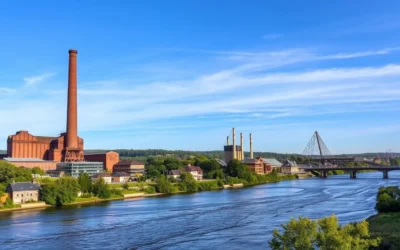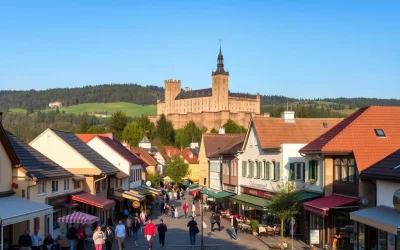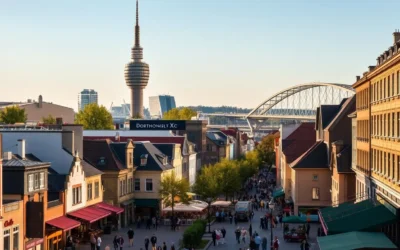✓ Accommodations✓ Flights✓ Rental Cars
Planning a trip? The weather plays a big role in making your adventure unforgettable. Whether you’re exploring vibrant cities or scenic landscapes, choosing the right time to visit can make all the difference.
This guide helps you pick the perfect season by analyzing weather patterns, local festivals, and climate insights. From mild temperatures to blooming cherry blossoms, May stands out as a great time visit. It offers pleasant days and fewer crowds, making it ideal for sightseeing.
You’ll also find detailed temperature and precipitation data for key cities like Dresden, Leipzig, and Chemnitz. Plus, we’ll share essential travel tips, from packing strategies to avoiding high tourist seasons. Understanding these details ensures your trip is smooth and memorable.
Introduction: Setting the Stage for Your German Adventure
Choosing the right time for your journey can transform your experience. The temperature and weather patterns vary significantly throughout the year, making some months more suitable for exploration than others. Whether you’re strolling through historic cities or hiking scenic trails, timing is everything.
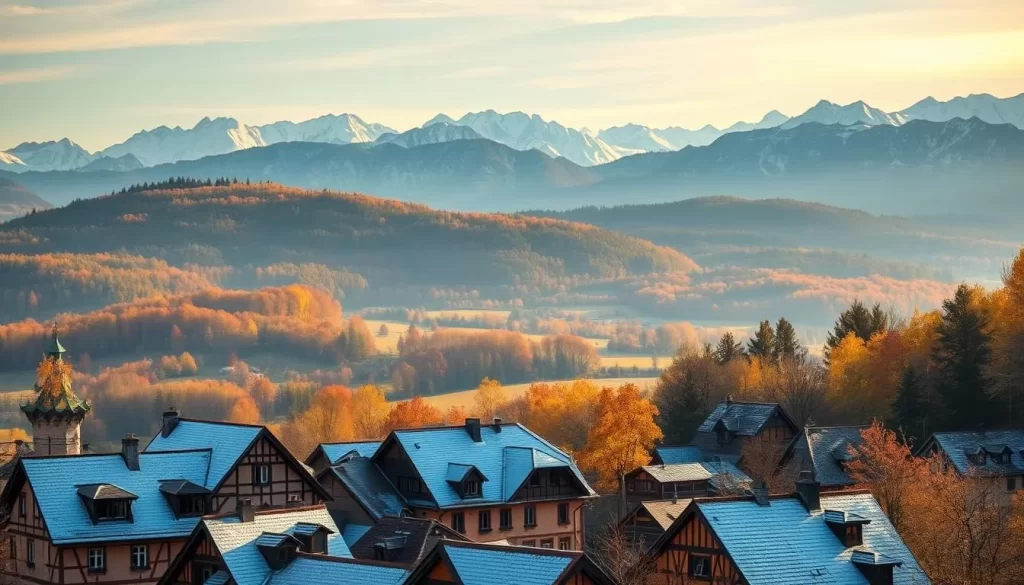
Why Timing Makes All the Difference
Each month brings unique conditions that can shape your trip. For example, spring offers mild temperatures and blooming landscapes, while winter transforms the place into a festive wonderland. Visiting during less crowded periods ensures a more relaxed and enjoyable experience.
Historical weather data shows that temperatures range from 5°C (41°F) in January to 20°C (68°F) in July. This means packing strategies and activity plans must adapt to the season. Understanding these patterns helps you avoid unexpected surprises.
What to Expect on Your Ultimate Trip
Throughout the year, you’ll encounter diverse conditions. Spring and fall are ideal for outdoor activities, with comfortable temperatures and fewer tourists. Summer attracts larger crowds but offers vibrant festivals and longer days.
Winter, though chilly, brings magical Christmas markets and snowy landscapes. By planning around these trends, you can maximize your adventure. Remember, the right month can turn a good trip into an unforgettable one.
Understanding Germany’s Seasonal Climate and Its Impact on Travel
Understanding the seasonal shifts can elevate your travel experience. Each season offers unique opportunities and challenges, shaping your itinerary in unexpected ways. From snowy winters to sunny summers, the climate plays a pivotal role in determining the best time to explore.
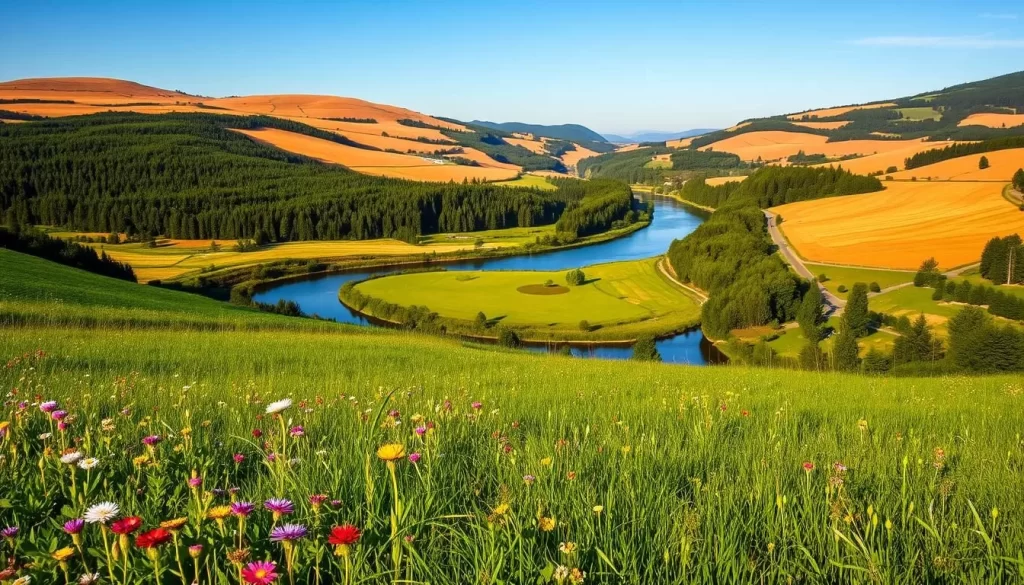
Overview of Germany’s Four Seasons
Germany’s temperate climate brings four distinct seasons, each with its own charm. Spring, from March to May, is marked by blooming landscapes and mild temperatures, perfect for outdoor activities. Summer, from June to August, is warm and bustling with festivals like Oktoberfest, attracting millions of visitors.
Fall, from September to November, offers crisp air and vibrant foliage, ideal for scenic drives. Winter, from December to February, transforms the country into a festive wonderland, with traditional christmas markets and snowy landscapes. Each season provides a unique backdrop for your travel adventures.
How Temperature and Rainfall Affect Your Plans
Temperature and rainfall are key factors in planning your trip. Summer highs can reach up to 75°F (24°C), making it ideal for outdoor festivals but also crowded. Winter temperatures drop to 23°F (-5°C), creating a magical atmosphere but requiring warm clothing.
Rainfall varies by season, with spring and fall seeing moderate showers. Unexpected weather changes can disrupt plans, so it’s wise to have alternatives. For example, if rain cancels a hike, visit a museum or enjoy a cozy café instead.
“The right season can turn a good trip into an unforgettable one.”
| Season | Temperature Range | Key Events |
|---|---|---|
| Spring | 40°F – 65°F (4°C – 18°C) | Cherry Blossoms, Beer Garden Openings |
| Summer | 65°F – 75°F (18°C – 24°C) | Oktoberfest, Freiburg Wine Festival |
| Fall | 40°F – 60°F (4°C – 15°C) | Pumpkin Festival, St. Martin’s Day |
| Winter | 23°F – 40°F (-5°C – 4°C) | Christmas Markets, New Year’s Eve |
By understanding these seasonal trends, you can choose the best time visit based on your preferences. Whether you’re drawn to the festive spirit of a christmas market or the sunny days of summer, planning around the climate ensures a smoother and more enjoyable trip.
Saxony, Germany: Best Months for a Weather-Savvy Trip
Exploring a new destination becomes even more rewarding when you time it right. May stands out as a standout month for travelers seeking a perfect balance of pleasant weather, vibrant culture, and fewer crowds. It’s a sweet spot between the chill of winter and the heat of summer, offering an ideal setting for unforgettable experiences.
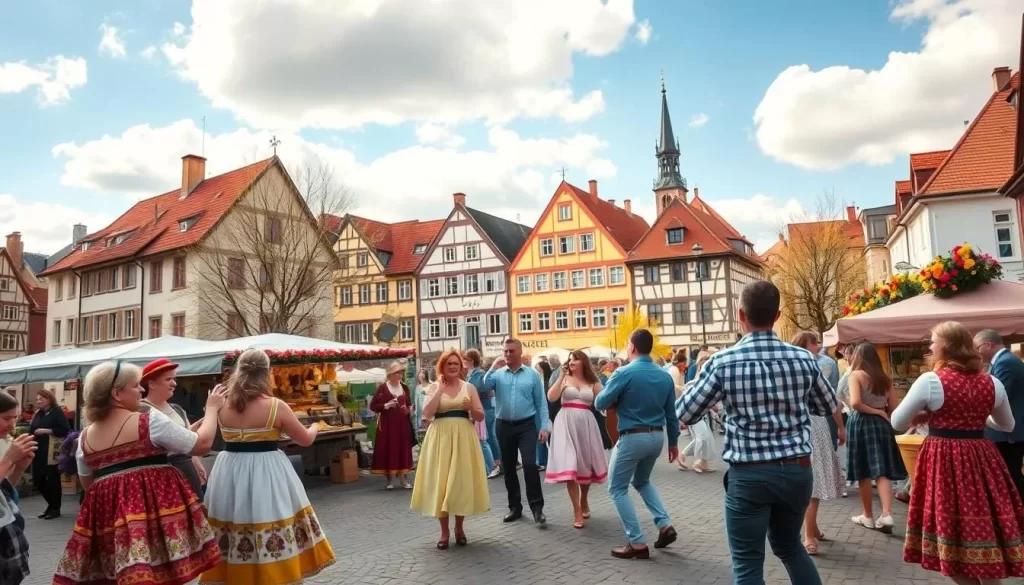
Why May Shines as a Travel Month
May brings mild temperatures, blooming landscapes, and a lively atmosphere. The weather is comfortable, with averages ranging from 50°F to 65°F, making it perfect for outdoor activities like hiking or strolling through historic streets. Unlike the crowded summer months, May offers a more relaxed pace, allowing you to enjoy attractions without long waits.
Local markets and spring festivals add a unique cultural flavor to your trip. Events like cherry blossom celebrations and beer garden openings create a festive vibe. These gatherings provide a glimpse into local traditions and offer opportunities to connect with the community.
Shoulder Seasons vs. Peak Times
Traveling during shoulder seasons like May has distinct advantages. Prices for accommodations and flights are often lower compared to peak summer months. You’ll also encounter fewer tourists, making it easier to explore popular sites and enjoy a more intimate experience.
In contrast, peak times like summer and December can be overwhelming due to large crowds and higher costs. While festivals like Oktoberfest and Christmas markets are magical, they often come with long lines and busy streets. May strikes a balance, offering festive vibes without the chaos.
“Traveling in May feels like discovering a hidden gem—comfortable weather, fewer crowds, and a vibrant cultural scene.”
| Season | Advantages | Challenges |
|---|---|---|
| May (Shoulder Season) | Mild weather, lower prices, fewer crowds | Limited availability for some events |
| Summer (Peak Season) | Festivals, longer days, warm weather | High prices, crowded attractions |
| Winter | Christmas markets, snowy landscapes | Cold temperatures, limited outdoor activities |
By choosing May for your trip, you’ll enjoy the best of both worlds—comfortable weather and a lively cultural scene. It’s a time when you can explore freely, immerse yourself in local traditions, and create lasting memories without the stress of peak travel seasons.
Regional Weather Insights: Dresden, Leipzig, and Chemnitz
Understanding regional weather patterns can enhance your travel experience. Each city in this area offers unique climatic conditions that influence your activities and itinerary. Whether you’re a tourist seeking sunny days or a traveler drawn to crisp fall air, knowing the weather trends helps you make the most of your visit.
Average Temperatures and Weather Trends
Dresden, Leipzig, and Chemnitz each have distinct temperature patterns. Dresden sees summer highs of around 72°F (22°C), perfect for outdoor festivals. Leipzig, known for its moderate climate, averages 68°F (20°C) in July. Chemnitz, slightly cooler, offers comfortable summer days with highs of 70°F (21°C).
In fall, temperatures drop to a pleasant 50°F (10°C), ideal for scenic drives and exploring local wine festivals. Winter brings colder weather, with Dresden averaging 32°F (0°C) and Leipzig experiencing about 50 frost days. These variations allow you to choose a destination that matches your weather preferences.
Precipitation Patterns and Clear Skies
Rainfall and sunny days also vary across these cities. Leipzig receives the most rain in July, with about 3.15 inches (80 mm). Dresden, on the other hand, enjoys around 160 sunny days from May to September, making it a great spot for outdoor activities.
Chemnitz offers a balance, with moderate rainfall and plenty of clear skies. Understanding these patterns helps you plan activities like hiking or sightseeing without unexpected interruptions. For example, if rain is forecasted, you can explore indoor attractions or cozy cafes instead.
“Knowing the weather trends of your destination ensures a smoother and more enjoyable trip.”
| City | Average Summer High | Rainfall (July) | Sunny Days (May-Sept) |
|---|---|---|---|
| Dresden | 72°F (22°C) | 2.8 inches (71 mm) | 160 |
| Leipzig | 68°F (20°C) | 3.15 inches (80 mm) | 150 |
| Chemnitz | 70°F (21°C) | 2.6 inches (66 mm) | 155 |
By analyzing these weather insights, you can choose the perfect destination for your trip. Whether you’re drawn to Dresden’s sunny days, Leipzig’s vibrant festivals, or Chemnitz’s balanced climate, planning around the weather ensures a memorable experience.
Optimal Times for Outdoor Activities and Local Festivals
Timing your visit to align with local events can elevate your travel experience. Whether you’re exploring bustling festivals or enjoying outdoor adventures, choosing the right season ensures a memorable trip. From lively beer gardens to enchanting Christmas markets, each event offers a unique cultural immersion.
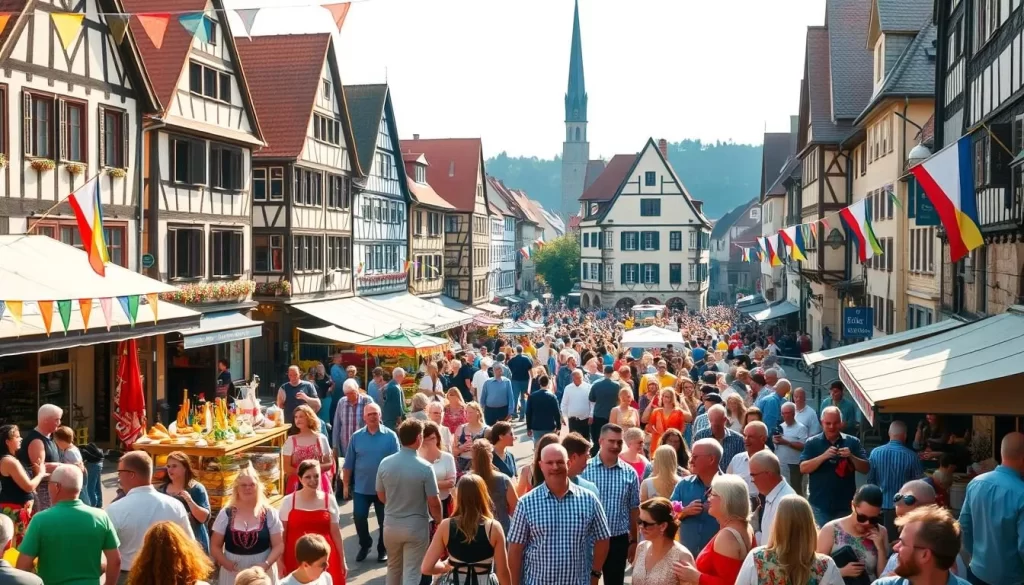
Exploring Local Festivals and Christmas Markets
Local festivals are a highlight of any trip. Oktoberfest, for example, is a must-visit event, offering a vibrant atmosphere and traditional beer experiences. It’s a great way to connect with local culture and enjoy authentic flavors.
During the holiday season, Christmas markets transform cities into magical wonderlands. Strolling through these markets, you’ll find handmade crafts, delicious treats, and festive decorations. Planning your visit around these events ensures a rich and authentic experience.
Seasonal Outdoor Adventures and Cultural Events
Outdoor activities thrive in the warmer months. From hiking scenic trails to attending public concerts, there’s something for everyone. Using a reliable guide can help you navigate busy weeks and make the most of your trip.
Night events, like neighborhood celebrations, offer a chance to experience local traditions. These gatherings often feature live music, food stalls, and community spirit. Balancing festival festivities with relaxation ensures a well-rounded adventure.
“Attending local festivals is like stepping into the heart of a culture—immersive, vibrant, and unforgettable.”
For more insights on , check out this detailed guide. It’s a great resource for planning your trip around these cultural highlights.
Navigating High Seasons and Budget-Friendly Travel Options
Making the most of your travel budget starts with smart timing. Traveling during off-peak periods can significantly reduce costs while offering a more relaxed experience. Whether you’re exploring wine regions or iconic world attractions, planning around quieter weeks ensures better deals and fewer crowds.
Traveling Off-Peak: Benefits and Savings
Choosing to travel during less busy times can save you money on flights, accommodations, and activities. For example, January and March often see lower prices as tourism slows down. This is a great opportunity to enjoy top attractions without the hustle and bustle of peak seasons.
Weather conditions, like occasional snow in winter, can also influence costs. While some outdoor activities may be limited, indoor attractions and cozy experiences often shine during these months. Plus, you’ll find more availability and flexibility in your itinerary.
Tips for Managing Crowds and Pricing
To avoid crowds, consider visiting popular spots early in the day or during weekdays. This strategy works well for wine tastings, museums, and scenic drives. Booking in advance can also secure better prices and ensure you don’t miss out on must-see experiences.
Flexible travel dates are another way to save. Shifting your trip by just a few days can lead to significant discounts on flights and hotels. For example, traveling right after major holidays often offers a quieter and more affordable course of action.
“Traveling off-peak is like discovering a hidden gem—lower costs, fewer crowds, and a more authentic experience.”
For outdoor enthusiasts, during shoulder seasons like spring or fall provides stunning views without the summer crowds. By planning strategically, you can enjoy the best of both worlds—savings and unforgettable adventures.
Packing and Preparation Tips for Every Season
Packing smartly for your trip ensures you’re ready for any weather surprises. Whether you’re exploring outdoor attractions or hitting the slopes, having the right gear makes all the difference. From waterproof layers for rain to thermal clothing for chilly air, preparation is key to a smooth adventure.
Essential Gear for Variable Weather
When packing, focus on versatility. A waterproof jacket is a must for unexpected rain, while layers like fleece or thermal tops adapt to changing temperatures. Comfortable walking shoes are essential for exploring attractions, especially if you’re spending a large part of the day outdoors.
For winter trips, don’t forget ski gear like gloves, goggles, and insulated pants. Even if you’re not hitting the slopes, these items keep you warm during cold evenings. Packing light but smart ensures you’re prepared without overloading your luggage.
Practical Preparation for Seasonal Changes
Planning for seasonal shifts helps you stay comfortable. In spring or fall, pack a mix of light and warm clothing to handle fluctuating air temperatures. Summer calls for breathable fabrics and sun protection, while winter requires heavy layers and accessories like scarves and hats.
If your trip includes ski adventures, ensure you have the right equipment. Renting gear locally can save space, but bringing essentials like thermal base layers ensures you’re ready for the cold. Always check the weather forecast before your trip to fine-tune your packing list.
“The right gear transforms your trip from stressful to seamless, no matter the weather.”
| Season | Essential Gear | Tips |
|---|---|---|
| Spring/Fall | Waterproof jacket, layers, walking shoes | Pack versatile clothing for temperature changes |
| Summer | Breathable fabrics, sunscreen, hat | Stay cool and protected from the sun |
| Winter | Thermal layers, gloves, ski gear | Prepare for cold and snow activities |
By following these tips, you’ll be ready for any weather conditions. Whether you’re exploring attractions or enjoying outdoor activities, smart packing ensures a hassle-free experience. Remember, the right gear makes every part of your trip more enjoyable.
Local Culture and Must-See Attractions in Saxony
Immerse yourself in the vibrant culture and iconic landmarks that define this region. From historic cities to traditional celebrations, every corner offers a unique experience. Whether you’re exploring architectural marvels or participating in local event festivals, you’ll feel the warmth of the community.
Discovering Historic Cities and Iconic Sites
Historic cities like Dresden and Leipzig are treasure troves of culture and history. Dresden’s Frauenkirche and Leipzig’s St. Thomas Church are must-see landmarks. These sites not only showcase stunning architecture but also tell stories of resilience and rebirth.
In winter, the occasional snowfall adds a magical touch to these cities. Walking through the streets feels like stepping into a fairy tale. Don’t miss the Zwinger Palace in Dresden, a masterpiece of Baroque design, or Leipzig’s vibrant art scene.
Experiencing Authentic Local Traditions
Local traditions come alive during event festivals. The Dresden Striezelmarkt, one of the oldest Christmas markets, is a highlight. Here, you’ll find handmade crafts, delicious treats, and a festive atmosphere that answers every question about holiday cheer.
Spring and summer bring lively celebrations like the Leipzig Bach Festival. These events line up with the cultural calendar, offering immersive experiences. Whether it’s music, food, or art, you’ll feel the warmth of local hospitality.
“Participating in local traditions is like becoming part of a story—one that’s been told for generations.”
| Attraction | Highlight | Best Time to Visit |
|---|---|---|
| Frauenkirche, Dresden | Baroque architecture | Year-round |
| St. Thomas Church, Leipzig | Bach’s final resting place | Spring for festivals |
| Zwinger Palace, Dresden | Art collections and gardens | Summer for blooms |
| Leipzig Bach Festival | Classical music celebration | June |
To make the most of your visit, consider booking a guided tour. This ensures you don’t miss key highlights and gain deeper insights. Alternatively, explore on your own to discover hidden gems. Either way, you’ll create lasting memories.
Conclusion
Discover how timing your trip can unlock unforgettable moments. Choosing the right season ensures a more relaxing and fulfilling experience. Whether you’re drawn to vibrant spring festivals or the cozy charm of early october events, each period offers unique opportunities.
Understanding seasonal weather, crowd levels, and price variations can significantly improve your planning. This guide serves as a roadmap to help you tailor your schedule for maximum enjoyment. From bustling events to quieter moments, every season has something special to offer.
Use these insights to craft your next holiday with confidence. A well-planned trip, whether during peak or off-peak times, promises cultural enrichment and adventure. Start exploring with the knowledge that timing truly makes all the difference.
The above is subject to change.
Check back often to TRAVEL.COM for the latest travel tips and deals.

